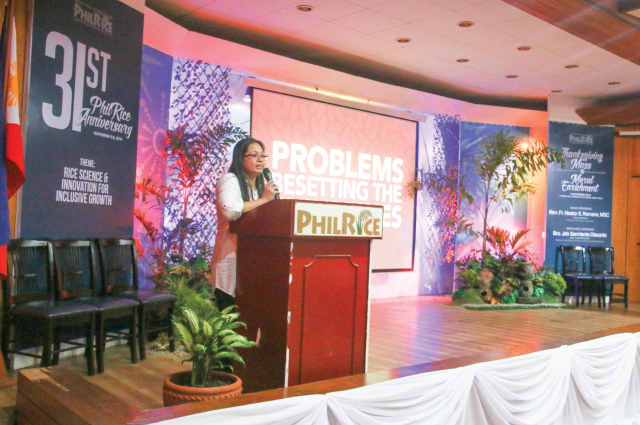 MUÑOZ, NUEVA ECIJA ― The Philippine Rice Research Institute kicked off the celebration of the National Rice Awareness Month (NRAM) during the celebration of the Institute’s 31st Anniversary, November 7.
MUÑOZ, NUEVA ECIJA ― The Philippine Rice Research Institute kicked off the celebration of the National Rice Awareness Month (NRAM) during the celebration of the Institute’s 31st Anniversary, November 7.
This year’s NRAM will focus on mainstreaming brown rice as an alternative food staple to white rice. Also known as pinawa, brown rice is a whole grain cereal produced by removing only the hull using mortar-and-pestle or rubber roller milling machine. The bran layer (darak) is retained giving the grain its brown color and keeping its high levels of soluble fiber antioxidants and other vitamins and minerals.
“The country faces problems such as undernourishment, low income of rice farmers, rice insufficiency, and hunger. To help address these issues, promotion of brown rice consumption is necessary,” said Dr. Flordeliza H. Bordey, PhilRice’s deputy executive director for development.
Social media campaign
The main activity of NRAM is the #BROWN4good Challenge, a social media campaign that seeks to promote brown rice as a “good” food, led by the Be Riceponsible Campaign.
First goodness is for the body noting its health benefits. Second is goodness for the farmers especially those who belong to farmer cooperatives that are linked to hotels, restaurants, supermarkets, and other market outlets for brown rice.
Third goodness is for the country. A PhilRice study revealed that brown rice has a 10% higher milling recovery advantage that would result in about 1.2 million MT additional edible rice supply. Lastly, the fourth goodness is for the less fortunate. Every hashtag is equivalent to one cup of brown rice which will be donated to partner-charities nationwide.
“We are eyeing at least 50,000 hashtags per region and we have partnered with the LGUs and DA-RFO as well as other groups for this,” said Hazel V. Antonio, campaign director of the Be Riceponsible Campaign.
Food and fashion
 Also part of the NRAM celebration is the opening of the exhibit titled Evolution of Novo Ecijano’s Farming System and Filipino Costumes, November 3.
Also part of the NRAM celebration is the opening of the exhibit titled Evolution of Novo Ecijano’s Farming System and Filipino Costumes, November 3.
“Agriculture is the common denominator of food and fashion. Most of the basic things that humans need for survival such as food, clothing…. are products of plant and animal farming,” Bordey said during the event. .
The exhibit, which will run until November 30 at the Central Luzon Agricultural Museum in Central Luzon State University (CLSU), highlights farm implements representing the emergence of Nueva Ecija as rice granary and the Ayala doll collection.
The featured farm implements, which were researched and curated by the Rice Science Museum, is part of its cultural mapping study being conducted in the country’s top rice producing provinces.
On the other hand, the 42-year-old doll collection dramatize the distinctive features of the Filipino clothes with some from farming communities. Made out of wood, the dolls have similar clothing materials and body adornments worn by the people they represent.
“But more than an appreciation for rice farming and Filipino costumes, [it is hoped] that the exhibit will spark meaningful conversations among stakeholders, [especially] the youth, on how we can take lessons from history and use these for individual growth and increased participation in nation-building,” she said.
Youth force in agri
In engaging the youth in nation-building, Bordey said that platforms, which the youth are receptive including fashion, must be used as Filipinos also better retain information through visual and interactive experiences.
Meanwhile, Dr. Melissa A. Agulto, CLSU vice-president for academic affairs, said that the exhibit makes the Novo Ecijanos proud of their farming heritage, encourages the youth to choose a career in agriculture, and challenges the audience to find nation-binding common themes amidst the county’s rich and cultural diversity.
“[Initiatives] like this, which aims to heighten the awareness and appreciation of one’s heritage and identity, play an important role in today’s globalized society. With the blurring of national boarders due to globalization, there is a need to remind ourselves of our roots, so that we may become global citizens but with deep understanding of our Filipino identity,” Agulto emphasized.
Kenneth C. Esguerra, Ayala Museum senior curator, added that the exhibit may also help in inspiring Filipinos to be involved in rice advocacies.
A partnership among Rice Science Museum of PhilRice, CLSU, local government of Science City of Muñoz, and the Ayala Museum, the exhibit expects 20,000 viewers. Queries and reservations can be made through the following numbers: (044) 456-0285 loc 530 or (0939) 154 5543.
NRAM is celebrated every November pursuant to Presidential Proclamation No. 524, s.2004.




